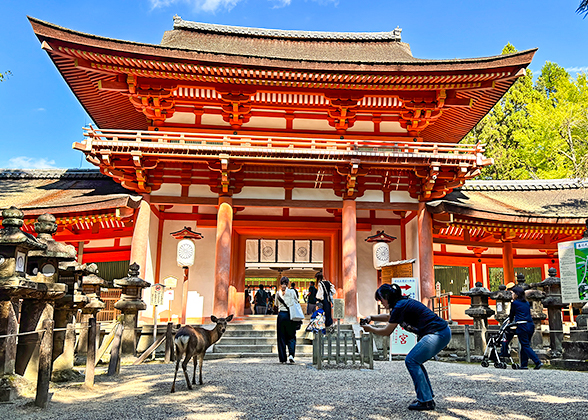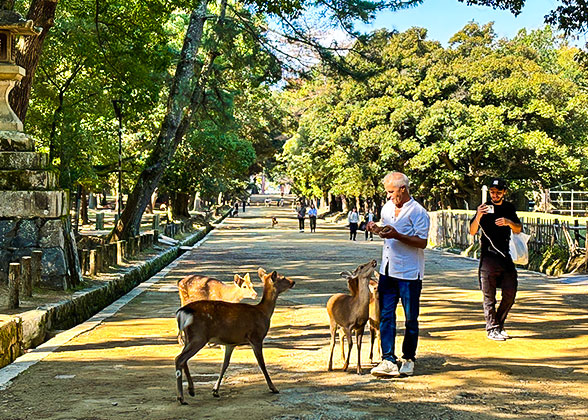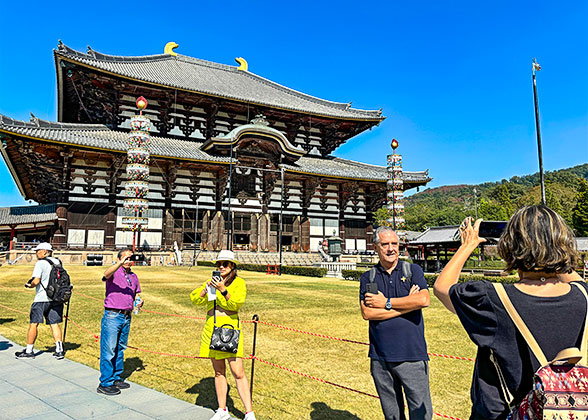Kasuga Taisha Shrine
Kasuga Taisha Shrine in Nara is surrounded by huge and ancient trees and there is only one road leading to the shrine, which is lined with stone lanterns and huge trees and where cute deer roam around. At the end of road, you will see the beautiful building dominated by vermilion and gold. Inside the shrine, you also can find more than 1,000 copper lanterns, some in golden color and some in bronze color.Besides, the Nara Kasuga Taisha Shrine is the headquarters of nearly 3,000 Kasuga Taisha Shrines throughout Japan, and it is known as the three major shrines in Japan together with Naign Shrine and Iwashimizu Hachimangu Shrine. Every morning and evening, rituals are held to worship the god, and up to 1,000 ceremonies are held a year in Kasuga Taisha shrine.
|
|
|
Over 1,200-Year History of Kasuga Taisha Shrine
Kasuga Taisha shrine was built in 768 and buildings in the shrine were torn down and rebuilt every 20 years before 1863. Considering the preservation of cultural assets, they have not been torn down and rebuilt after 1863, but still undergo major renovations every 20 years. The current Kasuga Taisha Shrine was reconditioned in 2016.Things to See and Do in Kasuga Taisha Shrine
1. Roam in the Sacred Path Full of Ancient Trees and Wild Deer
The bluestone-paved path is lined with towering trees and stone lanterns, and you can find deer moving around. Since the trees around the shrine have been forbidden to be felled for about a thousand years, these huge trees shield you from the sun and create a primeval forest atmosphere. Some deer will stand on stone lanterns and watch you from a distance. Once you have deer crackers, they will bow to you for food. Wild deer are always silly, and they even eat books, plastic, and other garbage. Therefore, please do not throw away rubbish and take care of your belongings.
|
|
|
2. Appreciate Wisteria in Manyou Botanical Garden
The botanical garden owns more than 300 species of plants, and the most famous are the wisteria trees. The wisteria flower is the symbol of Kasuga Taisha Shrine, and the shrine miko wears wisteria flowers as headdresses. The best time to see wisteria flowers is from late April to mid-May. You can appreciate more than 200 hundred wisteria trees with about 20 varieties in Manyo Botanical Garden. The oldest and largest wisteria tree here is called "Sunazuri no Fuji" and is estimated to be over 700 years old. Besides, the Manyo Gagaku Festival will be held on May 5 and November 3 here, allowing tourists to appreciate the ancient Japanese court music and dance.
3. Explore National Treasures in Kasuga Taisha Museum
The museum hosts nearly 3,000 objects, such as samurai armor, swords, and paintings. One of the most notable national treasures is the Alligator drum, which is the biggest Alligator drum in Japan. Besides, you can see the abundant masks, clothes, and musical Instruments that were used in sacrificial performances.4. Hang a Blessing Wooden Brand with Deer Shape
You can see plenty of wooden brands hanging everywhere in the shrine. People will write down their wishes on the wooden brand and pray that God can make them come true. Each wooden brand is charged about 500 yen. Besides, you can see many delicate little deer sculptures, and it also is charged about 500 yen each piece. It's nice to buy a deer sculpture as a tourist souvenir.|
|
|
5. See Lighted Lanterns
Each year the shrine holds the Setsubun Lantern Festival on February 3, during which visitors can see 3,000 lighted lanterns in the evening, including the stone lanterns along the sacred path.
In addition, one also can see the lighted lanterns in the Chugen Mantoro Lantern Festival, which is held on August 14 and 15. On the first night, traditional Japanese court music and dance are also performed and on the second night, drama and dance of the ancient Japanese Shinto religion are given.
Suppose you do not have the opportunity to appreciate the lighted lanterns during these festivals, you can visit the dark Fujinami-no-ya Room, where hundreds of lights are lit.
|
|
|
6. Taste Special Porridge in Garden Café
The Garden Café is hidden in the woods on the way to the shrine, providing indoor and outdoor seating. The most famous food here is Manyou porridge, which costs 1,000 yen. The type of porridge varies according to the season. For instance, you can taste seven grass porridge in January, cherry blossom porridge in April, cold porridge in July and August, and chestnut porridge in October.Opening Time
It is open from 6:30 to 17:30 between March and October; and from 7:00 to 17:00 between November and February.Ticket:
It costs none to enter the shrine. However, the worship in Kasuga Taisya Honden will be charged 500 yen. Besides, the tickets for Kasuga Taisha Museum and Manyo Botanical Garden are 500 yen each.How to Get to Kasuga Taisha Shrine
1. Take the Nara loop bus at JR Nara Station or Kintetsu Nara Station, and get off at the Kasugataisha-omotesando stop.2. Take a bus bound for Kasuga Taisha Honden at JR Nara Station or Kintetsu Nara Station, and get off at the Kasuga Taisha Honden stop.
Travel Advice
Kasuga Taisha Shrine shows the culture of Shintoism, and you can explore Buddhist culture at other nearby attractions in Nara Park, like Kofukuji Temple, Todaiji Temple, and Nara National Museum. Besides, you can visit Isuien Garden and Mountain Wakakusa not far away to enjoy natural views.
Read more:






